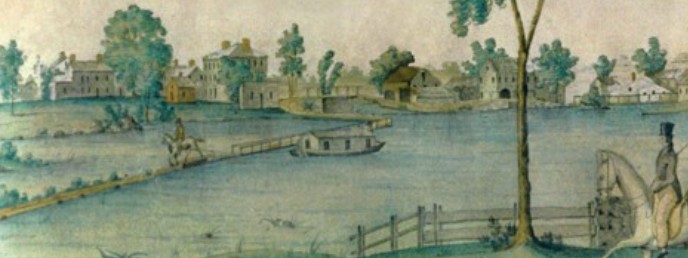


Middlesex Canal Association P.O. Box 333 Billerica, Massachusetts 01821
www.middlesexcanal.org
| Volume 54 No. 2 | January 2016 |
Please mark your calendars.
MCA Sponsored Events
Winter Meeting, 1:00pm, Sunday, February 14, 2016
Tom Dahill, “Summit Pond, Middlesex Canal, Circa 1822
Easter Sunday, March 27, 2016, Museum Closed
Bicycle Tour South, 10:43am, Sunday, April 3, 2016
Spring Walk, 1:30pm, Sunday, April 24, 2016
Woburn Cinemas
Spring Meeting, 1:00pm, Sunday, May 15, 2016
Speaker to be Determined
14th Bicycle Tour North, 9:00am, Saturday, October 1, 2016
Fall Walk, 1:30pm, Sunday, October 16, 2016
Winchester-Medford
Fall Meeting, 1:00pm, Sunday, October 30, 2016 Speaker to be Determined
The Middlesex Canal Visitor Center/Museum is open Saturday and Sunday, noon until 4:00pm, except on holidays.
The MCA Board of Directors meets the first Wednesday of each month, 3:30 to 5:30pm, except for July and August. Unless otherwise noted meetings take place at the Visitor Center/Museum, 71 Faulkner Street, North Billerica, MA.
TABLE OF CONTENTS
Editors’ Letter
Winter Meeting: February 14, 2016 - Dahill Lecture “Summit Pond”
President’s Message – J.J. Breen
Section #8 at Maple Meadow – J.J. Breen
Bill's 8 Years as Editor of TT Comes to an End – Betty Bigwood
Kudos to Traci – Betty Bigwood
More About Nolan – Bill Gerber
Fall Meeting Notes – Betty Bigwood and Tom Dahill
Asa Sheldon, a Wilmington Guy – Betty Bigwood
Count Rumford and the American Academy of Arts and Sciences – Betty Bigwood and Leonard Harmon
Outreach: J’s Extraordinary Effort This Fall – Betty Bigwood
Vose Lecture: Part I – compiled by Deb Fox
N. Billerica Mill Village: Part I – Alec Ingraham
Miscellany
EDITORS’ LETTER
Dear Readers,
Alec and I have returned with our second issue of Towpath Topics and we hope you will enjoy it as much as we have had putting it together.
Please check our calendar page first. We wouldn’t want you to miss any upcoming events especially the Winter Meeting in February. Our predecessor, Bill Gerber, always included national and international canal events, and in the last issue we directed readers to our website for that information. Unfortunately, that information is not there yet, but stay tuned we will be working to make it happen.
Highlights this month include articles by Betty Bigwood, an expanded obituary on former president, Nolan Jones, a message from our current president, the promised Vose lecture on Loammi Baldwi, Jr. and Part I of an article on the Billerica Mill Village in 1850 researched and written by Alec.
Again, we hope you enjoy this issue, but if you do not please let us know.
Deb Fox and Alec Ingraham
MCA Winter Meeting:
Sunday, February 14, 2016
At 1:30pm the Middlesex Canal Association will hold a public meeting at the Middlesex Canal Museum and Visitors’ Center, 71 Faulkner Street, North Billerica, MA. The featured speaker will be noted artist, author, and educator, Tom Dahill, Professor Emeritus of Fine Arts at Emerson College. The topic of his talk will be the two watercolors of the Middlesex Canal Summit Pond (circa 1822) in North Billerica. Both were assumed to be painted by Jabez Barton during his courtship of Rebecca Farmer Rogers, daughter of William and Hannah (Farmer) Rogers. A View from William Rogers House (Billerica Historical Society) provides a priceless early image of the floating towpath and the North Billerica Mill Village. The William Rogers House (New York Historical Society) portrays the scene from a point on or near the causeway at the east end of the summit pond. The William Rogers House was built about 1807 reportedly partly from funds earned by William in service of the Canal Proprietors, and stands today on Rogers Street.
For those planning to attend Professor Dahill’s February 14, 2016 lecture on the Barton watercolors, additional background information can be found in the following two publications:
Seaburg, Carl; Seaburg, Alan; & Dahill, Thomas. The Incredible Ditch: A Bicentennial History of the Middlesex Canal. The Anne Miniver Press for the Medford Historical Society, 1997.
Seaburg, Alan. Life on the Middlesex Canal. The Anne Miniver Press History of American Transportation Publications, 2009. Following Professor Dahill’s lecture there will be a short business meeting.
The Middlesex Canal Museum and Visitors’ Center is open every Saturday and Sunday, noon-4, except holidays.
MCA Board of Directors’ Meetings - The Board meets at the Canal Museum from 3:30pm to 5:30pm on the first Wednesday of each month with the exception of July and August. Members are welcome and encouraged to attend.
Directions to the Museum/Visitors Center: Telephone: 978-670-2740.
By Car: From Rte. 128/95, take Route 3 toward Nashua, to Exit 28 “Treble Cove Road, North Billerica, Carlisle”. At the end of the ramp, turn left onto Treble Cove Road toward North Billerica. At about ¾ mile, bear left at a fork. After another ¾ mile, at a traffic light, cross straight over Route 3A. Go about ¼ mile to a 3-way fork; take the middle road, Talbot Street, which will put St. Andrew’s Church on your left. Go about ¼ mile and bear right onto Old Elm Street. Go about ¼ mile to the falls, where Old Elm becomes Faulkner Street; the Museum is on your left and you can park across the street on your right, just beyond the falls.
From I-495, take exit 37, N. Billerica, south to the road’s end at a “T” intersection, turn right, then bear right at the Y, go 700’ and turn left into the parking lot. The Museum is across the street.
By Train: The Lowell Commuter Line runs between Boston’s North Station and Lowell’s Gallagher Terminal. Get off at the North Billerica station, which is one stop south of Lowell. From the station side of the tracks, the Museum is a 3-minute walk down Station and Faulkner Streets on the right side.
PRESIDENT’S MESSAGE
by J. Jeremiah Breen, President; jj@middlesexcanal.org
Billerica has 5.2 miles of the 27¼ miles of the Middlesex Canal, the most canal of the nine canal jurisdictions. Next in length of canal is Wilmington with 5.0 miles. Exceptional to Wilmington is four of the eight aqueducts: Maple Meadow Brook, Ipswich River, Lubber Brook, and Shawsheen River, the latter on the town line shared with Billerica. Billerica has two of the five walks sponsored by the Appalachian Mountain Club and the association: first walk, north from the summit pond and a half year later, south from the summit pond. Wilmington has the one walk: north from Town Park over Maple Meadow Brook to Patches Pond, 0.8 miles, and return, on 14 acres given to the association in 1983 by Stanley Webber and his daughter Julia Fielding.
Wilmington has the extant towpath with public access for a second walk centered on the Lubber Brook Aqueduct. Between the north end of the Lubber Brook towpath, 10 Wedgewood Avenue, and the brook is 1500’. Between the south end, Route 129, and the brook is 1400’. Access to the towpath from the cul-de-sac at 10 Wedgewood Avenue is through a 10’ wide walking easement and a conservation easement recorded as proposed in the 1992 deed, North Middlesex, book 6100, page 257. Access from Route 129 is down the concrete stairs (~ 27 Richmond St. 01887) built when Rte. 129 was re-located in 1974. [Details are available at http://www.middlesexcanal.org/photos/Lubber Brook]
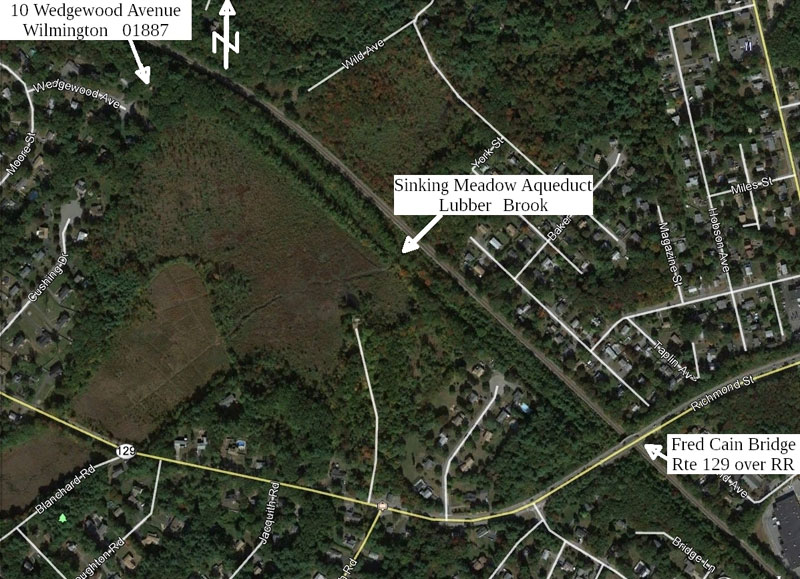
A Lubber Brook walk would be on the Wedgewood Avenue easements, then through a lot given to the association by the developer of Wedgewood Avenue [Betty Bigwood paid the back taxes.], on to land owned by Wilmington, and land of Mass Highways (Rte. 129). Perhaps the owners of 10 Wedgewood, Douglas and Michelle Hudson, who bought from the developer in 1992, would offer cookies and lemonade to AMC/MCA walkers. A video of a September 22, 2015 Lubber Brook walk was made by Tom Pazyra of Wilmington Community TV. [Tom Pazyra’s video of the walk is at https://vimeo.com/140827897.]
The 1400’ of canal south of Lubber Brook was developed as a Middlesex Canal Park when Route 129 was re-located in 1974. (That part of Shawsheen Avenue from which Route 129 was re-located continues to exist with the old railroad bridge replaced by a foot bridge.) The canal restoration in the park was done with a bottom width of 10’ to fit the land available and at the level of Lubber Brook. The water at the lower level of the brook is used to fill the restored canal as the connection to the Concord River no longer exists. The 1821 Brooks Bridge in Medford was the model for the culvert under Route 129. The steel plate culvert with a canal through it was very expensive and not needed for the highway, and was done only as a feature of the canal park. Betty Bigwood said President Wilbar Hoxie had a friend at Mass Highways who got the money for the park.
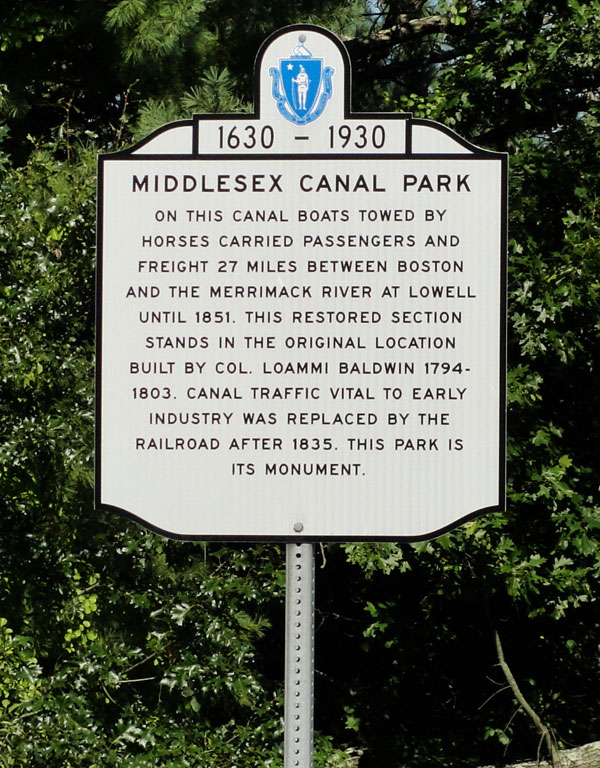
The dedication in 1974 of the restored canal was a grand affair with the guests of honor escorted to the canal by the Clan MacPherson Bagpipe Band. After a cannon salute by Lexington Minute Men, a horse-towed canal boat was launched. In the evening, a banquet with more speeches and a book signing celebrating the publication of Mary Stetson Clarke’s The Old Middlesex Canal was given. [Article on canal dedication, http://middlesexcanal.org/towpath/towpathtopicsJan1975.htm] Now Wilmington’s Middlesex Canal Park is little visited, and police officers interview the few who park at the sign.
J. J. Breen, MCA President
“Section No. 8 at Maple Meadow”
During the Association’s October 18, 2015 walk, J. Breen and Keith Morgan paced the 260’ north from Maple Meadow Aqueduct to the location of the section at Maple Meadow, No. 8 of ten cross -sections, or prisms, of the Middlesex Canal measured by George Baldwin in 1830.1 A 25’ surveyor’s pole was held at the water’s edge of the meadow in two locations on the towpath (east) side of the embankment. Neil Devins and Keith stood in the dry canal with their eyes level with the top of the towpath. The average of two measurements of the height of the towpath above the water was 13½’.
As measured by George Baldwin in 1830, the toe of the embankment was 13.5’ below the water surface in the canal, and the towpath was 1.0’ above, total 14½’.2 The measurement in 2015 was the height of the towpath above the water in the meadow. In 2015, the toe of the embankment was underwater either because the embankment had settled into the morass or because the beavers had dammed Maple Meadow Brook. Measuring the difference in elevation between the towpath at Section 8 and the towpath at the Ox Bow,3 mile 14, where the towpath was built on a solid hillside, would establish whether the morass or the beavers was the cause of the water over the toe of the embankment. As will become clear below, a difference of elevation of 10’ is the subject of this article, and observation of the elevation of the present towpath at Section No. 8 and that at the Ox Bow indicates a difference of much less than 10’. Conclusion: The measured 14½’ in 1830 is accurate though not equal to the 13½’ in 2015.

“An embankment at Maple Meadow in the town of Wilmington, is near 80 rods long, and 25 feet high to the top of the towing-path.” The citation for the 25’ quoted in Lawrence’s Middlesex Canal, 1942,4 is the Official Reports of the Canal Commissioners of the State of New York, 1817.5 No citation for the 25’ quoted in Clarke’s Middlesex Canal, 1974,6 but the Official Reports is in her bibliography. The basis for the 25’ in the Official Reports is the observations of two NY commissioners for the building of the Erie Canal, begun in 1817, who in May 1816 spoke with the superintendent and traveled the 27 miles of the Middlesex.7 The 25’ of 1816 is presumably an estimate made while the commissoners were standing on the towpath at Maple Meadow. During the 2015 fall walk, a visual estimate of 25’ from the towpath or the water’s edge of the meadow is credible until contradicted by the actual measurement. The sinking of the embankment into Maple Meadow between the estimate of May 1816 and the measurement in July 1830 is not a factor as the towpath would have had dirt added to keep the towpath the minimum 1 foot design height above the water in the canal. The canal water level is constant between locks at the minimum 3½’ design depth needed to pass boats over the miter sills and through the canal without grounding. Since the 25’ in 1816 is an estimate and the 14½’ in 1830 is an accurate measurement, the 25’ height of the Maple Meadow embankment in Lawrence and Clarke just repeats the erroneous estimate of 1816. The accurate, correct height of the Maple Meadow embankment is 14½’: Say fourteen feet as the towpath is more than the design 1’ above the water level in 1830 and 13½’ is roughly measured in 2015.
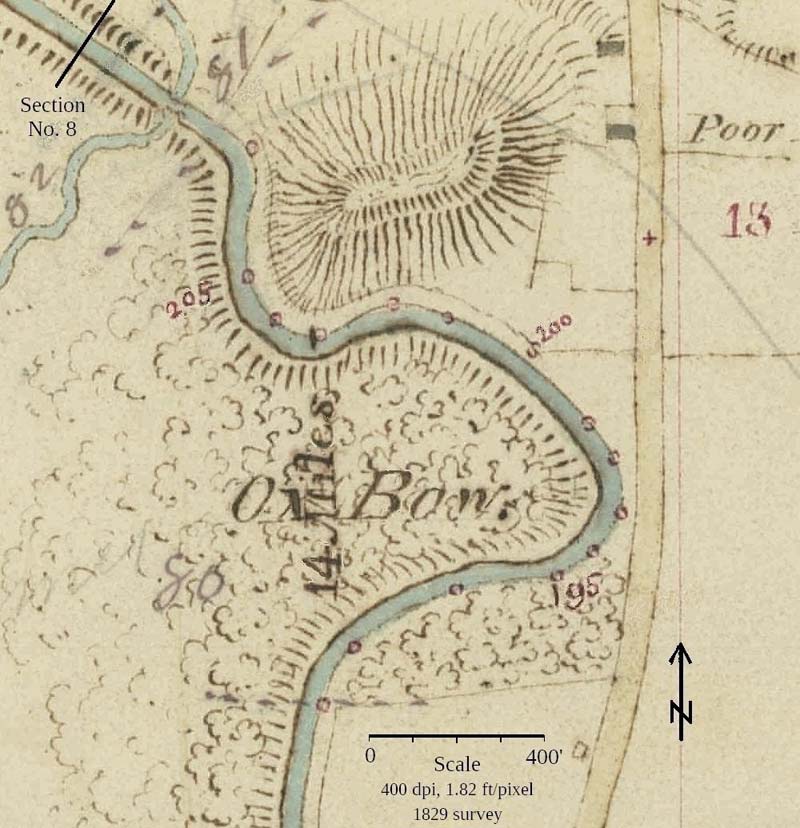
Notes:
1. “Section at Maple Meadow, No. 8”, location marked on George R. Baldwin’s 1830 Profile of the Middlesex Canal at 14 miles, 13 chains, 57 links from the Charles River. Sections of the Middlesex Canal. / Measured July 1830 for L. Baldwin, Esq., Civil Engineer. / By Geo. R. Baldwin. Profile and sections in the Internet Archive, https://archive.org/details/Middlesex_Canal_Plan_and_Profile. 14, 13.57 “Section at Maple Meadow, No. 8”, 259’ north of aqueduct (south abutment). 14, 9.64 Maple Meadow Brook Aqueduct, south abutment.
2. From Section No. 8. Toe, (13.54 + 13.39)/2 = 13.5’. Towpath, (1.45 + 1.60)/2 = 1.0’.
4. Lewis Morse Lawrence, The Middlesex Canal, manuscript, 1942, p. 30.
5. Official Reports of the Canal Commissioners of the State of New-York. (Newburgh, August, 1817). In Towpath Topics, Vol. 1, No. 2, copy of a re-print, New York: T.W. Mercein, printers, direction of NY Corresponding Association, 1821. http://middlesexcanal.org/towpath/canalnewsApr1964.htm
6. Mary Stetson Clarke, The Old Middlesex Canal (Melrose: The Hilltop Press, 1974), p. 49.
7. “The following information, respecting the Middlesex canal, was obtained in May last [1816], by two of the Commissioners, who visited and carefully examined that canal, throughout its whole extent, and committed to writing, on the spot, the results of their own observations, as well as the answers to all their inquiries, which were obligingly given, by the very intelligent agent (Mr. Sullivan) of the canal company. Op. cit., Official Reports
Bill’s Eight Years as Editor of Towpath Topics Comes to an End
by Betty M. Bigwood
On December 18, 2015 nineteen friends gathered for dinner at the Sichuan Gardens in the Baldwin Mansion to thank Lt. Col. William E. Gerber for editing Towpath Topics. Dave and Audrey Barber traveled the farthest (over 100 miles round trip) to join our group which we appreciated. Towpath Topics is our preeminent publication and when reading past publications you are very aware of what an outstanding group of friends compose the Middlesex Canal Association.
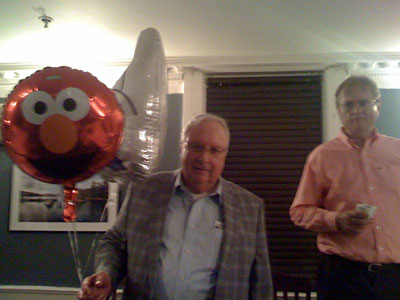 Bill Gerber in a festive mood as J led the toast |
Michael Duan, Sichuan Gardens owner, was most helpful in choosing an appropriate menu – we all agreed it was delicious! Michael has owned the Baldwin Mansion for 12 years. He is an opera singer and goes back and forth to China regularly where he teaches. His first restaurant was opened in Brookline – both are on the Top Chinese Restaurant List. We sat in two long tables in the first floor front parlor and I briefly thought of what went on there in the late 1700’s. I would have liked to have been a fly on the wall.
Eight years have passed quickly. Deb summed it up by saying when you finish one publication, you immediately start thinking about the next. It is an endless cycle of deadlines, cajoling members to write new articles, writing your own original work and vetting/editing to clarify and make it interesting. Bill graciously commented that it had been a learning experience for him.
Tom Raphael sprang for the bar costs which was a “Top Drawer” thing to do. Ran Duan, son of the owner, is a mixologist of international fame. So, J and I tried the “Father’s Advice” which was a recent competition winner. We kept toasts to a minimum with Tom Dahill and Roger Hagopian doing the honors.
This is a two man job – Editor and Publisher. In the background is the quiet, unassuming, reliable, knowledgeable Harvard and MIT mathematics lecturer Dr. Robert Winters who takes the information given him and turns it into the publication which arrives on our doorstep. In addition he has put all old Towpath Topics on our web site which he maintains.
As the evening came to a close, VP Traci Jansen passed out favors – cookies in glassé paper which she had baked and decorated. They were shaped like a canal boat on which was hand printed “Col. Gerber” in blue accompanied by a horse shaped cookie. It was a perfect ending.
KUDOS TO TRACI
by Betty M. Bigwood
This year (2015) we hosted every third grade student in the Town of Wilmington to the Middlesex Canal Museum and Visitor Center for a field trip. It would not have happened if it were not for Traci Benvenga Jansen, a third grade teacher and now a technology teacher for Wilmington.
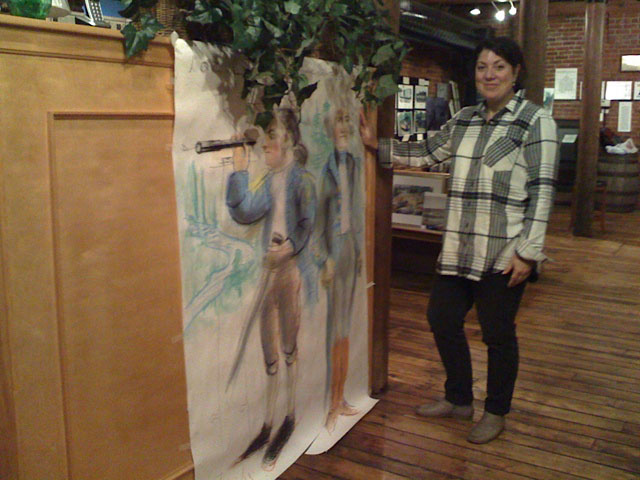 Traci prepares Dahill’s sketches of Loammi Baldwin and George Washington for her class |
The Board of Directors of the Middlesex Canal Association has long had a wish to have the history of the Middlesex Canal incorporated into the school curriculum – with special emphasis on the nine Towns through which the canal passed. The MCAS regulations allow local history to be taught in the third grade.
It is not as easy as it might appear to get the schools to come to the museum. Wilmington has 10 third grade classes in two separate buildings. Each has their own principal and decisions over which field trips to take. Most teachers have never heard of the Middlesex Canal and learning about it takes time and interest.
About 15 years ago I approached the Wilmington Schools again – I had been refused twice before. But this time, Assistant Principal Lori Neilson agreed to meet with us. Jean Potter who has taught school for years, artist and Professor Tom Dahill, a Lowell teacher and I went to the Roman House and met Ms. Neilson who brought along two teachers – Traci Jansen came from the Woburn Street School and the other came from the Shawsheen School. When Traci agreed to bring her students to our Museum we were thrilled. But unfortunately that meant that only half of the third graders in our Town came to our Museum.
Over the past fifteen years Traci has improved the program. Now she involves the parents who accompany the field trips in small groups with well planned outlines/activities and tasks who at 4-5 minute intervals change areas at the sign of a bell (my job). It keeps up the interest and time flies.
As Traci’s work environment changed – teaching technology to all grade schools – she developed an interest in the Shawsheen School coming to our museum. This finally occurred in October and all Wilmington third graders will be coming. Kudos to Traci!
MORE ABOUT NOLAN JONES
by Bill Gerber
The tenure of Nolan Jones as President of the Middlesex Canal Association encompasses a substantial portion of the history of the organization. Nolan held the office from 1983 to 1985, and was again elected President in 1994, serving into 2010 when a stroke cut short his term in office.
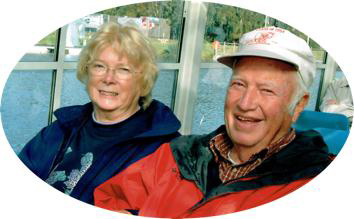 Nolan and Joan at the Falkirk Wheel in Scotland |
An examination of Nolan’s tenure, as recorded in Towpath Topics (TT) reveals both what took place during his time as well as what he himself did, and there’s certainly no lack of the latter.
Nolan first took office in the Spring of 1983. It was around mid-summer of 1985 that his employment took him to the west coast, and so his VP finished out his second year. During this short first term, Nolan led walks and organized visits to nearby canals in concert with the Canal Societies in other states. Characteristically, MCA public meetings were held at various places in communities through which the canal ran, making MCA activities more readily available to the people in those communities.
Nolan’s second term began in the Spring of 1994 and great things were accomplished over the ensuing years. Foremost was the more than a decade of work accomplished by Tom Raphael and Susan Keats that, ultimately, placed the entire entire length of the Middlesex Canal on the National Registry of Historic Places. The MCA, under Nolan, supported this effort in several ways. Contracts were let, deeds were searched, mailings and public meetings were held, and funds were raised to pay some of the bills, all to further this very important and ultimately successful endeavor.
The bicentennial celebration of the building of the Middlesex Canal, from almost the very beginning through to completion, occurred during Nolan’s second term. In recognition of this important accomplishment, Dave Dettinger researched, wrote, choreographed, directed and presented a series of reenactments and colloquiums, one per year over the full decade, to celebrate important achievement-related events. Most of the MCA Officers and Directors participated whenever an opportunity presented. It was for this series that Dave wrote the song “Hauling Down to Boston”, now the Middlesex’s challenge to the Erie Canal’s “Low Bridge” as a famous theater show tune.
The holding of public meetings at various places in communities along the canal was continued, some in cooperation with local historical societies, and this seems to have brought in members who, otherwise, might never have heard about the canal or the MCA. It also afforded abutters and the curious, in the communities along the way, an opportunity to learn more about this strange and unnatural depression that passed near or through their properties.
It was on Nolan’s watch that the Canal Commission, principally the Billerica section, opened the Middlesex Canal Museum and Visitors’ Center, which continues in operation to this day.
In the late ‘70s, a number of “Canal Crossing” signs were emplaced in Billerica, where prominent roads crossed extant remains of the canal. In addition, a number of stone monuments were emplaced along the route of the canal in each of the communities through which the canal passed. Shayne Reardon and Helen Knight unveiled one such monument in Billerica, the last to be emplaced.
It was in 1998 that the book “The Incredible Ditch”, authored by MCA members and Directors Carl and Alan Seaburg and illustrated by Tom Dahill, finally made it to the bookstores. It’s a wonderful “coffee table book” about the Middlesex Canal, and everyone should have one!
Throughout his long tenure, Nolan promoted and many times enabled outreach programs - an excursion through the Pawtucket Canal and out onto the Merrimack, a tour of the Delaware and Hudson Canal, attendance at World Canal Conferences, presentations at various symposia and to a wide variety of outside organizations. There were up to a half dozen such events in almost every year he was in office. In addition, setting an example, Nolan and his wife embarked upon tours and cruises on several of the canals of Europe, Canada, and the USA. These became regular events, soon emulated by Bruce McHenry and Martha Hazen, the Dettingers, the Raphaels, and others.
It was also on Nolan’s watch that a pattern of twice-annual walking tours of segments of the canal fell into place; annual bicycle tours of the entire length began; and the museum entertained annual visits of 3rd and 4th grade students from the Wilmington schools.
So, Nolan, you accomplished a lot, and promoted and enabled ever so much more. You are and will long continue to be missed.
FALL MEETING:
A much anticipated visit from Loammi’s grandson
by Betty M. Bigwood and Thomas H. Dahill
On Sunday, October 25, 2015 at 1pm the Middlesex Canal Association had as their guest speaker Dr. James George Baldwin, Ph.D., a Visiting Assistant Professor, Department of Earth and Environment at Boston University and fifth generation grandson of Loammi Baldwin, First Superintendent of the Middlesex Canal construction.
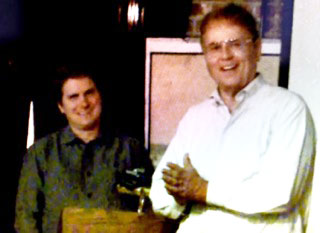 J Breen, on the right, introduces Dr. Baldwin at the Fall Meeting |
The lecture was identified as a “Change in the Use of Power in the Nineteenth Century.” Loammi’s sons and siblings were the transition from animal power to energy technology.
There were slides of the exterior and interior of the Baldwin Mansion prior to it being jacked up and pulled across Rte. 38 in 1972. It is an elegant house with a double stairway and four corner rooms on each floor with an L in the back. The original house was a one room home built in 1640. Which room that was is still a question today.
He spoke about and showed pictures of artifacts squirreled away in a mahogany family desk, such as an invitation from George Washington to dinner. An elegant Grandfather clock still works and they have original china.
The breadth of Loammi’s interests was illustrated by the papers on “Observations of the planet Venus” and one on the “Nature of Light” and his many activities following the Revolution. The camera obscura which he used in surveying the Middlesex Canal is still intact and was shown with written descriptions of its use.
Details of the genealogy of the Baldwin Family were given with emphasis on Loammi Baldwin, Jr. and his almost overwhelming accomplishments. Briefly his character was described as a buoyant personality in a large (over 6 ft.) figure, which family lore cites that was most impressive. He and Andrew Jackson did not get along. A notebook from classes at Harvard show skills in rendering in sketches - ideas which later led to drawings of his inventions and engineering projects. Loammi’s interests were primarily in the use of energy in transportation both by water and the railroad. He and his siblings were at the forefront of the transition.
The final slide: POWER=SURPLUS SAVINGS=INVESTMENT was followed by generous applause and a vigorous question and answer period.
Ham biscuits and Baldwin apple crisp were served.
ASA SHELDON AND PEMBERTON HILL
by Betty M. Bigwood
Boston when settled in 1630 was a scalloped peninsula jutting out into the harbor. It was connected to the mainland by a spicule of land which today is Washington Street. Over the next 250 years it doubled in size beautifully described by Nancy S. Seasholes in her book “Gaining Ground”.
Thousands of trees were felled in New Hampshire and floated down the Merrimack and the Middlesex Canal. Wharfs were built, mud flats were stabilized by pounding in thousands of pilings and back-filled, logs were placed in the sand in a tick-tack-toe grid which stabilized the area for rocks and fill. The dirt for fill came locally.
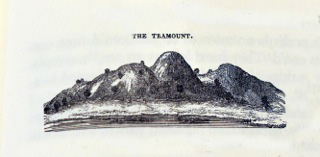 Mt. Vernon peak, Beacon Hill peak, and Pemberton Hill peak |
A dominant feature on the peninsula was a long mountain which had three (Tramount) “peaks”. For the first century and a half it remained undisturbed. When a signal for directing ship traffic was deemed necessary they chose the tallest middle “peak” upon which to place a Beacon and the name stuck. The Beacon Hill peak was lowered some 55 feet in 1811. The “peak” to the west named Mt. Vernon was brought down in 1799 using an inclined plane to form land along Charles Street next to the Charles River. The eastern “peak” was known as Pemberton Hill – moving this mound of dirt in 1835 became the job of Asa G. Sheldon (1782-1870), a Wilmington farmer and foremost contractor of his time. This was a big undertaking.
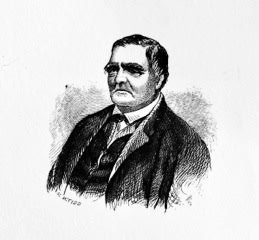 Asa G. Sheldon , a Wilmington guy |
Asa was well regarded in his Wilmington community. He had high ethical standards, gave fair prices, got the job done in agreed-upon time and treated his men fairly. When businessman and President of the Boston and Lowell Railroad Patrick Jackson watched Asa load a wagon of wood using oxen, he knew he had a winner.
Initially Jackson offered Asa a week’s work to prepare and outline a plan for moving Pemberton Hill into salt water on the north side of Causeway Street which would provide land for a train depot. Asa said it would cost approximately $10,000, but he wanted to be paid by the day – not a contract. This required some deliberation but was finally accepted. Asa hired 250 men and bought 126 oxen with carts. He preferred to use oxen because the cost of the harnesses were cheaper: (one leather horse harness = 12 oxen yokes) and at the end of the job he could sell them easier. The long and narrow ox carts were not like the rear dumping horse carts used in canal construction but instead dirt was taken from the long side by removing a plank – the entire load would slide out in about a minute.
Work began May 5, 1835. “The whole area, including adjoining streets was upwards of four acres, and it made in the water, eight acres, fourteen feet deep. The depth of the hill, from the highest point, was sixty five feet ten inches.” On average 14 ox carts per day were carried down. Asa said he could move the hill in 6 months but it was widely considered that he had grossly underestimated the job to be done – “couldn’t be done in 3 years he was told.” Asa kept going. In addition, there were six well-built brick houses to be moved, immense shrubbery and large English elms. He even managed to move to the Boston Garden for an additional $300 a large ginkgo tree and it still survives. He turned one of the houses destined to be demolished into a residence for the workers, provided them with good food and paid their agreed-to salary promptly. While he employed local teamsters to drive the carts, only Irishmen were employed to shovel. When the local farmers offered Asa’s men more money – he offered the same with the understanding they would get the bonus after the job was completed. He sprayed water along the streets to keep the dust down.
Asa understood how to get the best out of oxen and how to get the pairs to work well together. He provided grain, barns and a blacksmith shop to keep their hooves well shod. This blacksmith shop and its blacksmith (John Perry) were eventually moved to Wilmington where it became a well known business for a hundred years.
Things were going well, but Mr. Jackson grew inpatient and asked Asa how much it would cost to complete the job one month sooner. Asa told him the cost would be another $1000. Mr. Jackson agreed. The job was completed in 5 months on October 5, 1835. Asa Sheldon made a $1700.00 profit.
The Mill Creek portion of the Boston Canal was filled in between 1826-1828. The Mill Pond portion of the Boston Canal lasted another three years. Today the John Adams Courthouse lists its address as One Pemberton Square, Boston, Massachusetts.
Sources
(1) Asa G. Sheldon, Life of Asa G. Sheldon: Wilmington Farmer (Woburn, 1862)
(2) Walter Muir Whitehill, Boston, A Topographical History, The Belknap Press of Harvard University Press, Cambridge, Massachusetts, 1963, 244 pages
(3) Nancy S. Seasholes, Gaining Ground, the MIT Press, Cambridge, MA
(4) Wilmington Memorial Library, Town Crier, Larz Neilson, articles on Asa Sheldon
Count Rumford and the American Academy of Arts and Sciences
by Betty M. Bigwood/Leonard H. Harmon
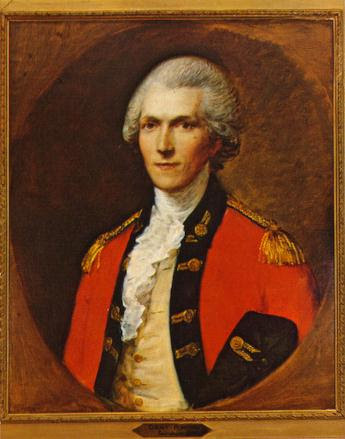 Count Rumford This is the portrait Winkler saw that started this discussion. |
In the last Towpath Topics (September 2015), Howard Winkler expressed his surprise at seeing a portrait of Benjamin Thompson, Count Rumford when recently visiting the American Academy of Arts and Sciences. Shortly thereafter I spoke with Len Harmon who is President of the Count Rumford Historical Association in North Woburn, Massachusetts. Len provided the following information:
Count Rumford, for whom the Rumford fireplace is named, was born Benjamin Thompson in Woburn, Massachusetts in 1753 and, because he was a loyalist, he left (abruptly) with the British in 1776. He spent much of his life as an employee of the Bavarian government where he received his title, “Count of the Holy Roman Empire.” Rumford is known primarily for the work he did on the nature of heat.
Back in England, Rumford applied his knowledge of heat to the improvement of fireplaces. He made them smaller and shallower with widely angled covings so they would radiate better. And he streamlined the throat, or in his words “rounded off the breast” so as to “remove those local hindrances which forcibly prevent the smoke from following its natural tendency to go up the chimney...”
Benjamin Thompson, Count Rumford (1753-1814) was a brilliant fellow and he knew it. He was not a modest man. In 1796 to assure his legacy and experiments in heat and light etc., he gave $5000 (approximately $92,700 in today’s dollars/Winkler) each to the Royal Society of Great Britain (London, England) and to the American Academy of Arts and Sciences (Cambridge, Massachusetts) to award a medal – The Count Rumford metal. This honor was to be given biennially and separately on each side of the “Pond” to a deserving scientist who had made advancements in heat and light research. A duplicate of each medal from the American Academy of Arts and Sciences has, until recently, been given to the Count Rumford Historical Association in North Woburn, Massachusetts.
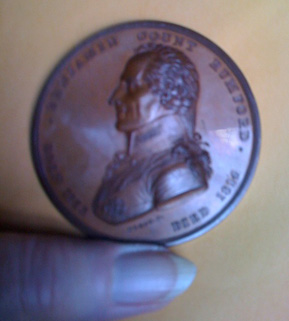 Count Rumford Medal |
The Royal Society of Great Britain gave the first award to, of course, Count Rumford. The Count luckily hired as one of his first scientists, Humphrey Davy whose foresightedness helped found and organize the Royal Institute (another organization) to not just maintain a museum of Count Rumford’s works but guide it into the leading scientific research institution which it is today.
The American Academy of Arts and Sciences gave a grant from the Rumford legacy to Sanborn C. Brown, Professor of Physics and Associate Dean of the Graduate School at Massachusetts Institute of Technology, to organize the complete works of Count Rumford. It is a five volume series called “The Collected Works of Count Rumford” (1970). Past MCA President Lou Eno left in his estate a complete copy of this series to the MCA.
The American awardees will not be mentioned here with one exception. Edwin H. Land won the Rumford Medal in 1945. I had special interest in this because MCA Director Thomas Raphael worked at Polaroid during which about half of Tom’s 16 patents were awarded. These awards came years after Land was honored. Of interest, is that Thomas Raphael recently applied for and received his 17th patent for a bicycle he is developing, in his own name for the first time, at the ripe old age of 93.
Outreach – J’s Extraordinary Effort This Fall
by Betty M. Bigwood
The Fall Bicycle Tour, the Fall Walk and the Fall Lecture were preceded by an extraordinary effort this fall to make the public aware of the opportunities to join us. J designed a number of posters for people to download and spread the word.
President J Breen , VP Traci Jansen and I collaborated with the Wilmington Community TV station – especially volunteer Tom Pazyra – to film an hour-long session in the studio to highlight upcoming events, and tell the history of the Middlesex Canal. President J and Tom Pazyra did a second hour-long show filming along the Rte. 129 section highlighting the Lubber’s Brook Aqueduct. It was so dry this year that they were able to walk around the remains of the “Sinking Meadow Aqueduct/Lubbers Brook Aqueduct” and along the area restored in 1974 near the Fred F. Cain Bridge where Col. Hoxie had MassDOT replicate the Brook’s Bridge to keep the canal open for passage. These DVD’s have run off-and-on for months on the Wilmington Community TV station. Many thanks to Tom Pazyra for his editing expertise.
Dick and Roberta Bauer had to initially cancel the Fall Bike Ride because of inclement weather, but rescheduled a week later (from Oct. 3rd to Oct. 10th). About a dozen people came and stopped briefly by the museum for refreshments. This is a hearty group who exercise while learning history on the spot!
The Fall Walk started in the Wilmington Town Park. This section, which the MCA owns, was given by Stanley Webber and daughter Julia Fielding and is one of our most beautiful walks. Bill Gerber, Neil and Harrison Devins arrived at our house with SUV and roof rack to pick up a ladder, boards and rope to build a bridge across the Maple Meadow Brook. It proved a challenge this year as a beaver and his/her dam was well under way. J and Jan Devins also arrived at the aqueduct, so with this good group they managed to forge a pathway for the walkers. Robert Winters and Renée Chipman arrived early in good spirits, with handouts, to lead the walk. The McInnis Family has for some years provided the walkers with refreshments, but they were away, so a neighbor did the honors, and their efforts were much appreciated. This is always a good walk with the tow rope lines and aqueduct so obvious.
The Fall Lecture by Loammi’s Grandson – five generations later - was much anticipated and described elsewhere.
Life of Loammi Baldwin
“A Sketch of the Life & Works of Loammi Baldwin Civil Engineer”
Introduction to the Vose Lecture: Part I in the Series
compiled by Deb Fox
document supplied by Susan Williams
One of the items emailed to the editors was a text from a speech given on September 16, 1885 to the Boston Society of Civil Engineers. It is entitled “A Sketch of the Life & Works of Loammi Baldwin Civil Engineer” and was given by George L. Vose, Harvard Professor of Civil & Topographical Engineering at MIT. Too long to run in its entirety in one issue, we have decided to publish it in serial form. Long-time Towpath Topic readers may already know all the details of the life of Loammi Baldwin, Jr., but this 19th century speech is worth reading for the eloquence of the language and Mr. Vose’s admiration for his subject.
Loammi Baldwin
No man so well deserves the name of the Father of Civil Engineering in America as Loammi Baldwin. Living, as he did, before the days of the railway system, and almost before engineering was recognized as a profession, his name is known to very few at the present time; but there is no one man among the leaders of industrial work in this country to whom we owe more. There were very few works of internal improvement carried out in America during the first thirty years of the present century with which Mr. Baldwin was not connected; and his two great works, the Government dry docks at Charlestown and at Norfolk, stand today unsurpassed among the engineering structures of the country.
In Sewell’s History of Woburn, we have the following in regard to the Baldwin family:-
“During the Revolutionary War, two gentlemen, natives of Woburn, attained the great eminence in society, of whom it seems a matter of right that some particular notice should be taken. To begin with the elder of the two, Col. Loammi Baldwin, he was the son of James and Ruth (Richardson) Baldwin, and a descendant in the third generation from Deacon Henry Baldwin, one of the first settlers of Woburn, and the subscriber of the ‘Town Orders’ drawn up at Charlestown for the regulation of the projected new settlement, in December, 1641. James Baldwin was by trade a carpeneter, and is reported to have been a master workman in the erection of the Burlington meeting-house, in 1732, which building is still standing.”
“Loammi Baldwin, the elder, was born at New Bridge (North Woburn), Jan 21, 1745. Discovering from early life a strong desire for acquiring knowledge, he was a constant attendant upon the instruction of Master Fowle, for many years a noted teacher of the grammar school in Woburn. At a more advanced period in life, with a view to obtaining an acquaintance with Natural and Experimental Philosophy, he was accustomed to walk from North Woburn to Cambridge, in company with his schoolmate, Benjamin Thompson (afterwards Count Rumford), to attend the lectures of Prof. Winthrop; and, upon their return home, they were wont to make rude instruments for themselves, with which to illustrate the principles they had heard laid down in the lecture room at the college.”
“At the commencement of the war, in 1775, Mr. Baldwin enlisted in the regiment of foot commanded by Col. Samuel Gerrish. Here he was rapidly advanced to be lieutenant-colonel; and, upon the retirement of Col. Gerrish from the army in August of that year, he was put at the head of the regiment, and not long after was commissioned to be colonel. The regiment was originally known as the Thirty-eighth, and consisted of eight companies, all of them stationed at the Boston lines. On the reorganization of the army, at the close of 1775, it included ten companies and was known as the Twenty-sixth. Till the end of 1775, Col. Baldwin remained near Boston; but in April, 1776, he followed Washington to New York City, and there we find him on June 22, at the Grand Battery, in command of the main guard. When Washington was compelled by superior numbers of the enemy to evacuate New York, and retreat to the western side of the Delaware, Baldwin with his men followed him; and, on the memorable night of December 25, they accompanied the Commander-in-chief in the desperate expedition which resulted in the capture of the Hessian troops at Trenton.”
“Col. Baldwin was honorably discharged from the Continental army about 1777, on account of ill health. In 1780, he was appointed High Sheriff of Middlesex, being the first who held that office in the country after the adoption of the State Constitution. He also represented Woburn in the General Court for many years. He was one of the original corporators and principle proprietors of the Middlesex Canal, - an undertaking in which he took great interest, and to which he gave a large amount of his time, the entire work being constructed under his superintendence. He was always much interested in farming, and in the cultivation of fruit; and it is to him that we are indebted for the well-known Baldwin apple, which he perfected and brought into use.”
Col. Baldwin’s first wife was Mary, daughter of James Fowle, Esq., for many years town clerk of Woburn. His children were: 1. Cyrus; 2. Mary; 3. Benjamin Franklin; 4. Loammi; and 5. James Fowle. His second wife was Margaret, daughter of Josiah Fowle, of Woburn, and his children by her were: 1. Clarissa, the wife of Thomas B. Coolidge; and 2. George Rumford. Col. Baldwin died Oct. 20, 1807, and is buried in the family tomb at Woburn.
James F. Baldwin, who was born in 1782, settled as a merchant in Boston, was a member of the Senate for Suffolk, made the first surveys for the railroad from Boston to the Hudson River, had charge of the construction of the Boston and Lowell Railroad, and was one of the commissioners for introducing water to Boston from Lake Cochituate. He died in 1862.
George R. Baldwin was born in 1798, and he became an engineer. When quite a young man, he built the graceful elliptical stone arch across the Middlesex Canal, in the fine estate of Peter C. Brooks, in Medford, one of the few structures upon that work which yet remain. He was a particularly fine draughtsman, as shown by his numerous plans still in existence. He designed and built the Boston Marine Railway, and was the consulting engineer for the Charlestown water works, and also the engineer of the water works at Quebec. He prepared the plans for the improvement of the Shubenacadie Canal in Nova Scotia, which, although not carried out, for lack of funds, were sent to England, and approved by the best engineering authority. He was also connected with the early surveys for the Cape Cod Canal, and was consulted by the State in regard to improvement of the South Boston flats. He is still living, at the advanced age of eighty-seven years.
Loammi Baldwin, the younger, and the subject of our sketch, was born at North Woburn, May 16, 1780. He fitted for college at Westford Academy, and entered Harvard in 1796, graduating with the famous class of 1800, in which Lemuel Shaw, Joshua Bates, Washington Allston, Charles Lowell, Joseph Buckminster, and other noted men. While in college, his inclination seems to have been toward mechanical subjects, to which, however, very little attention was paid at the time. It was during his college life that he made with his own hands a clock, which kept very good time, and was the wonder and admiration of his class. At the semi-annual visitation of the Committee of the Overseers, preceding Commencement, we find Baldwin put down as No. 9 on the list for “an exhibition in mechanics.” At Commencement, he does not seem to have had any part; but, in 1806, he is recorded as vice-president of the Phi Beta Kappa, John Thornton Kirkland being president.
It was while Mr. Baldwin was in college that we find his father writing (Nov. 4, 1799) to his friend, Count Rumford, then living in London, as follows: -
“I have a favor to ask of you, my dear sir; and I feel confident that you will indulge me in the request I am about to make. I have already told you that I have a son at college, whose genius inclines him strongly to cultivate the arts; and I think it rather doubtful whether he will apply his studies to either the learned professions with that success as to become eminent. I have therefore thought whether it would be best to endeavor to provide him with a place for a year or two with some gentleman in the mathematical line of business in Europe, who is actually in the occupation of making and vending mathematical and optical instruments in an eminent degree. Perhaps a character something similar to what Mr. George Adams, of London, was, might suit. It may be that you know of one good place. In this, I wish for your assistance so far as to make inquiry whether he could get admitted, what the terms would be, what kind of rank he would be considered to have in such a place, where he might work at some branches of the business as well as attend on customers. In short, I wish to know all about it. Perhaps he may settle a profitable correspondence in trade with the same gentleman, when he comes to return to this country. He is very lively, ready, and enterprising, and has ever sustained a good character. I have raised expectations of his usefulness, if I can but hit his prevailing genius.”
In reply to the above, Count Rumford writes, from Brompton, as follows:
“I have consulted Mr. Frazer, of New Bond Street, Mathematical Instrument Maker to his Majesty, and learn that the instrument making business is divided into two distinct branches in London, - namely, working instrument makers and shopkeepers; and that though some few of the great shopkeepers, such, for instance, as Ramsdem, Dolland, Adams, Frazer & Co., have workshops in their houses and employ some workmen, yet that by far the greater part of the articles in which they deal are made by manufacturers, who live in their own private houses and keep no open shops. Working instrument makers take apprentices, who are bound for seven years; and, with them, they commonly receive a premium of about fifty or sixty pounds. The great dealers in mathematical instruments also take apprentices, but they have seldom opportunities of much practice in making instruments. They learn to know the construction of them, and to judge of their merit of work and of the defects and perfection of the instruments in which they deal; and they likewise learn to make instruments to pieces, to clean them and to examine their accuracy. But no instrument maker or dealer in instruments would, without a very large premium, undertake to instruct a young gentleman in the course of two or three years, and make him perfect in both branches of the trade. Mr. Frazer thinks that it would not be possible to get your son into one of the shops in London, for a term of from two to four years, for a less premium than from sixty to a hundred pounds; your son to be boarded in the house free of cost to you or to him during that period.”
This scheme does not seem to be followed any farther. Like many others, Mr. Baldwin does not seem to have found out at once for what he was intended. Upon graduating from college, he entered the law office of Timothy Bigelow, at Groton. But, even here, Nature asserted her rights, and we find him constructing a fire-engine, of which the village stood in desperate need; and this small machine is still in active service, after a use of over eighty years, and will today throw a stream over the highest roof in town. This engine was made in the shop of Jonathan Loring, directly opposite the blacksmith shop where the iron-work was done.
In a paper called the Fireman’s Standard (published in Boston, in 1884), there is a description of the above engine, from which the following is taken: -
“In the year 1800, a young gentleman graduated from Harvard University, settled in Groton, and studied law. The young gentleman was Loammi Baldwin, who in 1802 built, at his own expense, the still serviceable hand fire-engine known as Torrent, No. I. This old engine, built in the third year of our century, by private enterprise, can throw a stream through a five-eighths inch nozzle to the height of 75 feet, and when needed is manned by volunteers. The old machine has a quaint appearance, with its copper tub, on which is inscribed its name, ‘Torrent, No. I,’ and its ancient tool-box, which bears the date of its birth, 1802. The tub is 3 feet 6 inches long, 2 feet 2 inches wide, and 22 inches deep. On its bottom rests an oak plank, in which are set the valves, and in which stand the brass cylinders and the air chamber, the cylinders being 5 inches in diameter and 16 inches high. A goose-neck on top of the air-chamber serves as an outlet for the water; and a reel is attached to the hind part of the tub capable of carrying 100 feet of 2-inch hose, the first supply of which was made at the harness-shop and sewed with waxed thread.”
“At two different times within a few years,” says Dr. Green, “Torrent, No. I has done most excellent service in putting out fires, on both occasions it prevented a serious conflagration.”
(Continued in the next issue)
The following contains the first two parts of an article written and researched by Alec. The final three parts will appear in the next issue.
The North Billerica Mill Village in 1850
As Told Through Selected Town Valuation Records
by Alec Ingraham
Part I: Introduction
In 1850 the Middlesex Canal Company, which had dominated the North Billerica Mill Village for over 50 years, was nearly defunct. The last official trip along the full length of the 27½ mile canal, which permitted travel from the Merrimack River above the Pawtucket Falls in Lowell to the tide water in Charlestown, occurred on November 25, 1851. The Canal Proprietors would soon meet for the last time, and the Massachusetts Legislature would revoke the charter in 1859.
The Canal Company relied heavily on the dam across the Concord River in North Billerica to supply the water necessary to operate the canal. There are many who were of the opinion that the Middlesex Canal promoted the industrial growth in Billerica but there were still others who feel the insatiable demand for water to fill the canal and keep the boats and rafts afloat hindered growth.
The canal’s fate was sealed in 1830 when the Boston and Lowell Railroad was chartered. Its route nearly paralleled that of the Middlesex. Ironically the first steam engine purchased by the railroad was transported by the canal to Lowell for final reassembly. In 1835 the first train set out along the route. It was evident that the railroad would prove more reliable than the canal for the conveyance of freight and passengers. The rails were quickly extended to Nashua and to Concord, New Hampshire robbing the canal of the business once supplied by the Merrimack River Canals.
In 1850 the Town of Billerica taxed its citizens on the real estate to which they held title and on their personal property. Personal property included the following: farm animals (horses, cows, oxen, swine and sheep), carriages, investments (mostly in railroads, banks, and insurance companies, and money held at interest). The tax rate (Town, County, and Overlaying Town and County) on both was 39 cents per hundred dollars of valuation. In order to vote in elections male citizens had to pay an additional $1.50 poll tax. Women did not have the right to vote.
At the time the median real estate value was $1380. The smallest tax bill was 6 cents and the largest $138.00. There were 513 households evaluated and almost 40% registered no real or personal property.
The following is a more detailed and specific analysis. The individuals were selected based on their association with the Middlesex Canal Company, the Mill Village, and its budding textile industry. They include Daniel Wilson, Israel Colson, Joel Dix, John Mixer, Thomas Talbot, and James R. Faulkner, and William E. Faulkner.
Part II: The Canal People
A. Daniel Wilson
About 1830 Daniel Wilson, a carpenter by trade, and his wife Mary arrived in the Mill Village. He hailed from Bow, New Hampshire and had previously worked for the Middlesex Canal Company. In 1831 he purchased land in the Village from the Canal Proprietors. By 1850 he was residing in the home which he built on Old Elm Street. His home is now the Parish House of the North Billerica Baptist Church. Daniel was the foreman for the Middlesex Canal operations in the Mill Village. Charles H. Kohlrausch, in his memoirs notes that Daniel was frequently referred to as “Boss” Wilson, a sobriquet fitting his position.
Real Estate (Daniel Wilson)
| Description | Acres | Value | Total | Tax on Same |
| Homestead | 23 | $5500 | ||
| 1/3 Tavern Stand | 1/2 | $1100 | ||
| Bussy Place | 1/2 | $1300 | ||
| Farmer Lot | 11 | $165 | ||
| $8172 | $31.87 |
Notes: The Tavern Stand was situated on the corner of Old Elm and Wilson Streets on land acquired by Nathan Mears from the Proprietors in 1812. (See Joel Dix)
Isiah Bussy, a clothier, purchased lot from the Middlesex Canal Company. He evidently worked for the Faulkner Mill. His house is still extant at 22 Old Elm Street. He was among the first individuals to purchase one of the lots set aside by the Canal Company for people working in the Mill Village. The Gilson Hill Lot was most probably a wood lot.
Personal Property (Daniel Wilson)
| Description | Value | Tax on Same |
| 3 horses, 2 oxen, 2 cows, 4 swine, 1 yearling, 15 shares of Lowell Bank: $1500, 10 shares of Lowell & L RR: $1000, stock in trade $2000, Money at Interest $2000 |
$7465 | $29.11 |
Notes: The Lowell and Lawrence RR was chartered in 1846. The stock in trade was most probably associated with running the tavern. The Lowell Bank was chartered in 1828 with a capital of $250,000.
Daniel Wilson’s total tax including the poll tax was $62.48. His tax bill was among the ten highest in Billerica at the time.
B. Israel Colson
In 1850 Israel Colson lived on Colson Street in the Federal Style, “brick end” house on the square where Colson Street crosses Old Elm Street. The house was built in 1803 by Oliver Farmer on land he acquired from his wife’s father. Israel took possession of the house by virtue of his marriage, in 1832, to Rachel Farmer, daughter of Oliver and Hannah (Sprake) Farmer.
Census records reveal that Israel arrived in the Mill Village around 1830 from Rhode Island. He considered himself a farmer by trade but he was also an apprentice to Daniel Wilson. In 1833 he was heavily engaged with the construction of the Red Locks, situated just east of his home. These would be the last set of locks constructed by the Middlesex Canal Company Proprietors. They permitted boats to pass into the Concord River below the falls. Goods destined for the budding metropolis of Lowell were shipped through this lock.
Real Estate (Israel Colson)
| Description | Acres | Value | Total | Tax on Same |
| Homestead | 85 | $3500 | $3500 | $13.65 |
Personal Property (Israel Colson)
| Description | Value | Tax on Same |
| 1 Horse, 2 Oxen, 6 Cows, 2 Swine, 5 Shares in L&L RR: $500, $500 Money at Interest | $1880 | $7.33 |
Israel Colson’s total tax including poll tax was $22.48.
C. Joel Dix and John Mixer
Joel Dix came to the Mill Village from Chelmsford about 1820. In 1822 he purchased the home and property of two blacksmiths. The land was situated adjacent to the Mears Tavern Stand on Old Elm Street. In 1815 the blacksmiths had purchased the lot from the Middlesex Canal Proprietors. Unfortunately the house was set ablaze in 1996 and has subsequently been razed and replaced by a duplex (# 8 and #10 Old Elm Street). Joel would marry Pricilla Parker in 1823 and his sister, Nancy would marry John Mixer. John lived immediately across Old Elm Street from the Bussy House. Today his house, now gone, would have been located in the Pace Industries parking lot. He too purchased his lot from the Canal Company. In 1850 both families were living in the Mill Village.
Joel was a canal boat “captain”, farmer, and tavern owner. Although a legend and a matter for debate he was the last man to navigate the canal, making his journey on April 4, 1852. The Canal Company had ceased operations during the prior year but reportedly Joel worked many of the gates himself. John Mixer, who arrived in the Mill Village from New Hampshire, was a “boatman and general factotum” for the Proprietors. By 1853, it appears John had built a house on Boston Road near Alpine Street.
Real Estate (Joel Dix)
| Description | Acres | Value | Total | Tax on Same |
| Homestead | 2 1/2 | $2000 | ||
| 3 Lots in Broadmeadow | 17 | $340 | ||
| Ingalls Place | 1/2 | $25 | ||
| Plain Land | 5 | $80 | ||
| Patten Land | 18 | $950 | ||
| Tufts Land | 9 | $225 | ||
| 2/3 of Tavern Stand | 1 | $2300 | ||
| Total | $6160 | $24.02 |
Notes: The Tavern Stand was owned in conjunction with Daniel Wilson. The broadmeadow extended northward from the outskirts of the Mill Village along the west bank of the Concord River toward the Chelmsford Town Line. The other lots were not located in the Mill Village although further research will need to be completed to determine where they were. (See Daniel Wilson)
Personal Property (Joel Dix)
| Description | Value | Tax on Same |
| 1 Cow | $20 | $0.08 |
Joel Dix’s total tax including the poll tax was $25.60.
Real Estate (John Mixer)
| Description | Acres | Value | Total | Tax on Same |
| Homestead | 1/2 | $1350 | ||
| Sprague Land | 22 | $700 | ||
| Total | $2050 | $8.00 |
Notes: The Sprague (Sprake) Land is the property near the junction of Boston Road and Alpine Street.
Personal Property (John Mixer)
| Description | Value | Tax on Same |
| 1 Cow | $20 | $0.08 |
John Mixer’s total tax including the poll tax was $9.58.
(Continued in the next issue)
MISCELLANY
Nameplate – Excerpt from a watercolor painted by Jabez Ward Barton, ca. 1825, entitled “View from William Rogers House”. Shown, looking west, may be the packet boat George Washington being towed across the Concord River from the Floating Towpath at North Billerica.
Back Page – Excerpt from an August,1818, drawing (artist unknown) of the Steam Towboat Merrimack crossing the original (pre-1829) Medford Aqueduct, probably on its way to service on the Merrimack River.
Estate Planning – To those of you who are making your final arrangements, please remember the Middlesex Canal Association. Your help is vital to our future. Thank you for considering us.
Museum & Reardon Room Rental – The facility is available at very reasonable rates for private affairs, and for non-profit organizations’ meetings. The conference room holds up to 60 people and includes access to a kitchen and rest rooms. For details and additional information please contact the museum at 978-670-2740.
Web Site – As you may have noted in the nameplate, www.middlesexcanal.org is the URL for the Middlesex Canal Association’s web site. Our webmaster, Robert Winters, keeps the site up to date, thus events and sometimes articles and other information will sometimes appear there before we can get it to you through Towpath Topics. Please do check the site from time to time for new entries. Also, the site now contains a valuable repository of historical information, all the back issues of TT, and an index to all of the articles contained therein, can now be found there at http://middlesexcanal.org/towpath.
Back Issues – Fifty years of back issues of Towpath Topics, together with an index to the content of all issues, are also available from our web site at http://middlesexcanal.org/towpath. These are an excellent resource for anyone who wishes to learn more about the canal and should be particularly useful for historic researchers. Instructions for conducting a word search within the back-issues archive can be found in TT 1/2014, see “Searching our Online Archives”.
Museum Shop – Looking for that perfect gift for a Middlesex Canal aficionado? Don’t forget to check out the inventory of canal related books, maps, and other items of general interest available at the museum shop. The store is open weekends from noon to 4:00pm except during holidays.

Towpath Topics is edited and published by Debra Fox, Alec Ingraham, and Robert Winters.
Corrections, contributions and ideas for future issues are always welcome.